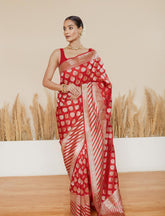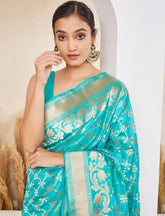From Loom to Luxury: The Journey of an Authentic Banarasi Saree
Few garments can match the timeless beauty and grandeur of a Banarasi saree. This elegant piece of clothing, deeply rooted in India’s cultural heritage, has long been cherished for its intricate designs and luxurious fabric. But what makes an authentic Banarasi saree so special, and how does it transform from raw silk on a loom to a work of wearable art? Let’s take a closer look at the journey of an authentic Banarasi saree—from loom to luxury.
1. The Rich Heritage of Banarasi Sarees
The history of Banarasi sarees can be traced back to the Mughal era, when the art of weaving fine silk and intricate zari (gold and silver thread) was introduced to Varanasi (also known as Banaras). Over the centuries, Banarasi sarees have come to represent the pinnacle of Indian craftsmanship, blending cultural influences from Mughal, Hindu, and even Buddhist traditions. Today, these sarees remain a symbol of elegance, beauty, and tradition, adored by brides, celebrities, and saree enthusiasts across the globe.
2. The Weaving Process: A Labor of Love
The creation of a Banarasi saree is an art form passed down through generations of skilled artisans. It all begins with the selection of high-quality silk, which forms the base of the saree. Once the silk is chosen, the magic of weaving begins.
-
Handlooms: While some modern Banarasi sarees are woven on power looms, the most authentic and sought-after varieties are still made on handlooms. The process of weaving a single saree can take anywhere from 15 days to 6 months, depending on the complexity of the design. This meticulous craftsmanship is what gives Banarasi sarees their unique charm and rich texture.
-
Zari Work: One of the hallmarks of a true Banarasi saree is its intricate zari work. Artisans use gold and silver threads to weave detailed patterns inspired by Mughal architecture, such as floral motifs, jaal (net-like patterns), and paisleys. The shimmering zari not only adds a touch of luxury to the saree but also makes it an heirloom-worthy piece.
3. The Design: An Ode to Tradition
The designs of Banarasi sarees are often inspired by nature, mythology, and history. From elaborate floral motifs to intricate peacock designs, each Banarasi saree tells a story through its patterns. Some of the traditional motifs include:
- Butidar: One of the most common designs, featuring small, repeated motifs of flowers or leaves woven with zari.
- Jangla: A more intricate design with large floral and foliate patterns spread across the saree.
- Tanchoi: A specialized weaving technique that creates a densely woven fabric with floral or paisley motifs in contrasting colors, often without zari work.
Each design is carefully planned before the weaving begins, ensuring that the final product is both aesthetically pleasing and true to its cultural roots.
4. The Colors: Vibrancy and Symbolism
Banarasi sarees come in a variety of colors, each chosen with careful consideration. Traditionally, rich and deep colors like red, gold, maroon, and royal blue were favored, especially for bridal sarees. However, modern interpretations have expanded the palette to include pastel shades, metallic tones, and unique color combinations. The vibrancy of the colors, combined with the shimmer of the zari, creates a stunning visual effect that enhances the beauty of the wearer.
5. The Final Touches: Quality and Authenticity
After the weaving is complete, the saree undergoes a series of finishing touches to ensure its quality. The fabric is inspected for any flaws, and any loose threads or imperfections are corrected. Once the saree passes these quality checks, it is ready to be adorned by its future owner. A true Banarasi saree is known for its durability and will often be passed down through generations as a treasured family heirloom.
6. The Luxury of Wearing a Banarasi Saree
The journey of a Banarasi saree from loom to luxury doesn’t end with the artisans. When you drape yourself in an authentic Banarasi saree, you become part of a centuries-old tradition of elegance, artistry, and cultural heritage. Whether you’re wearing it for a wedding, a special celebration, or just to feel beautiful, a Banarasi saree has the power to make any moment feel extraordinary.
The rich texture, the shimmering zari, and the intricate patterns all come together to create a saree that is not just a piece of clothing, but a work of art. It’s a garment that exudes luxury, making every woman who wears it feel regal and confident.
Conclusion: Celebrate Craftsmanship with Paridhanam
At Paridhanam, we take immense pride in offering authentic Banarasi sarees that carry forward this rich legacy of craftsmanship. Each saree in our collection is carefully curated to reflect the tradition, beauty, and luxury that Banarasi sarees are known for. When you choose a Banarasi saree from Paridhanam, you’re not just buying a saree—you’re investing in a piece of history, a symbol of timeless elegance, and a garment that will be cherished for generations to come.
Discover the beauty of Banarasi sarees at Paridhanam, where every saree has its own story to tell, and every woman becomes a part of that story.





